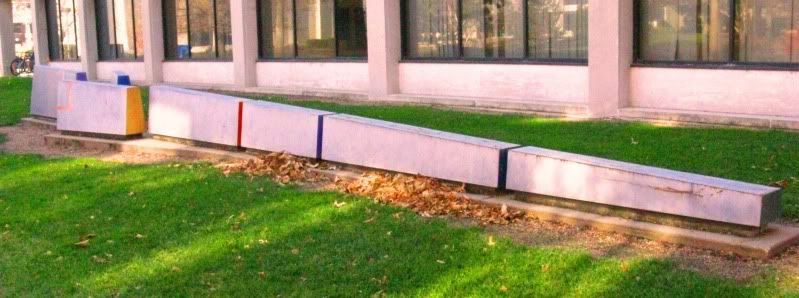
Through the course of this writing project, I have asked myself a number of questions; I have often wondered, "What is art?" Through further examination of art objects I have developed some answers to this question. Art is produced using skill, which is "acquired by experience, study, or observation" in a creative fashion for the purpose of creating an aesthetically pleasing outcome (Merriam-Webster). It required some artistic skill to create "Variable Wedge," the art object located in the Sheldon Memorial Sculpture Garden between the Westbrook Music Building and Architecture Hall. The composition of the shape, line, and colors of the sculpture required some type of artistic skill, as did working with the metal to produce a product that was uniform and attractive. This abstract art object could be seen as "art for art's sake," or a piece of art that was constructed solely for "its own intrinsic value ... produced not for the public's sake," but I would argue that this is not the case (Witcombe).
If "Variable Wedge" were simply "art for art's sake," there would be no greater meaning other than the whims and desires of the artist. The seven pieces of steel that are poured and arranged to create this art object could have no "edifying, utilitarian, or moral function" (Witcombe). This certainly wouldn't make for a very exciting writing project! Instead, we can reconsider the art object in question as an "intensification" of what we originally perceived it to be. Instead of seeing this art object only for its aesthetic value--seven pieces of wedge-shaped steel painted gray and accented using complementary colors--we can view it through an exaggerated lens. That said, this art object could represent a number of things. The term wedge can describe an object that is "driven into something ... causing breach or separation" (Merriam-Webster). The pieces of the wedge seem to be coming together, aligning and rising from the ground to separate the Westbrook Music Building from the rest of campus. In the area adjacent to this building on the southwestern part of campus a number of performing arts edifices are located--The Kimball Recital Hall, Johnny Carson Theatre, Lied Center for Performing Arts, and Temple Building. Does this pending separation help explain that the performing arts are separate from the visual arts? Several buildings that house classes for the visual arts lie across the rift created by this wedge--Architecture Hall, Sheldon Memorial Art Gallery and Sculpture Garden, the Woods Art Building, and Richards Hall. Did the procurer of this art object want to punctuate this growing rift? I wonder if this sentiment hold true now as it did over twenty years ago when the art object was acquired? This would suggest that the fourth dimension, time, is a factor in unpacking the meaning of this sculpture.
We could also view this sculpture as an intensification of the natural environment in which it is located. The landscape of Nebraska is relatively flat. The terrain lacks dramatic differences in elevation, and the rolling hills and bluffs have long eroded from the majestic mountains over the last few million years. This sculpture, with its conic peaks, "contrasts with the flat, plain terrain on which it is placed" (Sheldon Sculpture Brochure). This contrast intensifies the meaning of this sculpture, and the gray finish lends to an interpretation of the art object as a mountain range. The seven peaks present a great obstacle that seems impenetrable from a distance. As the distance decreases, the viewer realizes that there is not one, unit but several individual "peaks" united by a series of valleys. These valleys provide division--enough to provide a pass. Through this expanded view of the art object in the natural environment surrounding it, the viewer's perspective shifts and requires a reevaluation of what was first viewed as an issue. Intensification is necessary to view the art object in this light.
Works Cited
"Art." Merriam-Webster Online Dictionary. 2009. Merriam-Webster Online. Accessed 30 Nov. 2009 from http://www.merriam-webster.com/dictionary/art.
"Sheldon Memorial Art Gallery and Sculpture Garden." Brochure. Lincoln: A to Z Printing. Accessed 30 Nov. 2009 from http://sheldonartgallery.org/photos/graphics/sculpturebrochure.pdf.
Witcombe, Christopher L. C. E.. ""Art for Art's Sake"." Modernism. Web. Accessed 30 Nov. 2009 from http://witcombe.sbc.edu/modernism/artsake.html
No comments:
Post a Comment